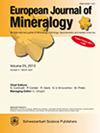Dislocation and disclination densities in experimentally deformed polycrystalline olivine
IF 1.7
3区 地球科学
Q2 MINERALOGY
引用次数: 2
Abstract
Abstract. We report a comprehensive data set characterizing and quantifying the geometrically necessary dislocation (GND) density in the crystallographic frame (ραc) and disclination density (ρθ) in fine-grained polycrystalline olivine deformed in uniaxial compression or torsion, at 1000 and 1200 ∘C, under a confining pressure of 300 MPa. Finite strains range from 0.11 up to 8.6 %, and stresses reach up to 1073 MPa. The data set is a selection of 19 electron backscatter diffraction maps acquired with conventional angular resolution (0.5∘) but at high spatial resolution (step size ranging between 0.05 and 0.1 µm). Thanks to analytical improvement for data acquisition and treatment, notably with the use of ATEX (Analysis Tools for Electron and X-ray diffraction) software, we report the spatial distribution of both GND and disclination densities. Areas with the highest GND densities define sub-grain boundaries. The type of GND densities involved also indicates that most olivine sub-grain boundaries have a mixed character. Moreover, the strategy for visualization also permits identifying minor GND that is not well organized as sub-grain boundaries yet. A low-temperature and high-stress sample displays a higher but less organized GND density than in a sample deformed at high temperature for a similar finite strain, grain size, and identical strain rate, confirming the action of dislocation creep in these samples, even for micrometric grains (2 µm). Furthermore, disclination dipoles along grain boundaries are identified in every undeformed and deformed electron backscatter diffraction (EBSD) map, mostly at the junction of a grain boundary with a sub-grain but also along sub-grain boundaries and at sub-grain boundary tips. Nevertheless, for the range of experimental parameters investigated, there is no notable correlation of the disclination density with stress, strain, or temperature. However, a broad positive correlation between average disclination density and average GND density per grain is found, confirming their similar role as defects producing intragranular misorientation. Furthermore, a broad negative correlation between the disclination density and the grain size or perimeter is found, providing a first rule of thumb on the distribution of disclinations. Field dislocation and disclination mechanics (FDDM) of the elastic fields due to experimentally measured dislocations and disclinations (e.g., strains/rotations and stresses) provides further evidence of the interplay between both types of defects. At last, our results also support that disclinations act as a plastic deformation mechanism, by allowing rotation of a very small crystal volume.实验变形多晶橄榄石中的位错和向错密度
摘要我们报告了一个全面的数据集,该数据集表征和量化了1000和1200下晶粒图框中的几何必要位错(GND)密度(ραc)和细粒多晶橄榄石变形的双轴压缩或扭转中的向错密度(ρθ) ∘C、 在300的围压下 MPa。有限应变范围从0.11到8.6 %, 应力高达1073 MPa。该数据集是以传统语言分辨率(0.5∘)但以高空间分辨率(步长在0.05和0.1之间)获得的19个电子背散射衍射图的选择 µm)。由于数据采集和处理的分析改进,特别是使用了ATEX(电子和X射线衍射分析工具)软件,我们报告了GND和向错密度的空间分布。具有最高GND密度的区域定义子晶粒边界。所涉及的GND密度类型也表明大多数橄榄石亚晶界具有混合特征。此外,可视化策略还允许识别尚未很好地组织为亚晶界的次要GND。低温和高应力样品显示出比在类似有限应变、晶粒尺寸和相同应变速率的高温下变形的样品更高但组织性较差的GND密度,证实了这些样品中位错蠕变的作用,即使是微米晶粒(2 µm)。此外,在每个未变形和变形的电子背散射衍射(EBSD)图中,都可以识别出沿晶界的向错偶极子,主要在agrain边界与亚晶粒的交界处,也可以沿亚晶粒边界和亚晶粒边界尖端。然而,对于所研究的实验参数范围,向错密度与应力、应变或温度没有显著的相关性。然而,在每晶粒的平均向错密度和平均GND密度之间发现了广泛的正相关关系,证实了它们与产生晶间取向不良的缺陷的相似作用。此外,发现向错密度与晶粒尺寸或周长之间存在广泛的负相关性,从而提供了关于向错分布的第一经验法则。由实验测量的位错和向错(例如应变/旋转和应力)引起的弹性场的场位错和向差力学(FDDM)提供了两种类型缺陷之间相互作用的进一步证据。最后,我们的结果也支持向错是一种塑性变形机制,通过允许非常小的晶体体积旋转。
本文章由计算机程序翻译,如有差异,请以英文原文为准。
求助全文
约1分钟内获得全文
求助全文
来源期刊
CiteScore
2.80
自引率
9.50%
发文量
40
审稿时长
6-12 weeks
期刊介绍:
EJM was founded to reach a large audience on an international scale and also for achieving closer cooperation of European countries in the publication of scientific results. The founding societies have set themselves the task of publishing a journal of the highest standard open to all scientists performing mineralogical research in the widest sense of the term, all over the world. Contributions will therefore be published primarily in English.
EJM publishes original papers, review articles and letters dealing with the mineralogical sciences s.l., primarily mineralogy, petrology, geochemistry, crystallography and ore deposits, but also biomineralogy, environmental, applied and technical mineralogy. Nevertheless, papers in any related field, including cultural heritage, will be considered.

 求助内容:
求助内容: 应助结果提醒方式:
应助结果提醒方式:


